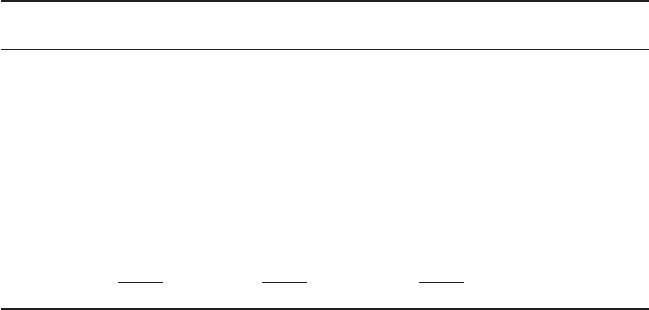
This bond is priced at a discount. When the coupon is less than the yield,
the resulting price will be a discount (less than 100). The discount will be
accrued (or accreted) over the life of the bond. We will discuss this process
later. 䊏
E
XAMPLE 6.2. A 12% bond, due in 5 years, at a 6% yield. Here we have
a coupon stream of 10 payments of size 6. Consulting the tables, or comput-
ing, we have
The present value of the final maturity amount will be 100 (par value) times
.74409391 (the present value of 1) = 74.409391
The present value of the annuity will be 6 (the size of the semiannual coupon
payment) times 8.53020284 (the present value of an annuity of 1) =
51.181217
Price of bond = 74.409391 + 51.181217 = 125.590608
125.590, truncating to three places
Note also that this agrees with the reasonableness check amount.
This bond is priced at a premium. If the coupon rate is higher than the
yield, the bond will be priced at a premium.
The premium will be amortized over the life of the bond. We discuss this
process in the next section. 䊏
AMORTIZATION OF PREMIUM AND ACCRUAL
OF DISCOUNT
Suppose you buy a bond at a discount or at a premium. You have paid a price
different from par, but your bond will mature at par. This will give you a gain if
you bought at a discount, or a loss if you bought at a premium. Usually, this
premium or discount is written off or accrued over the life of the bond. Your
actual earned income is adjusted each year to reflect this accrual or amortization.
This can also have tax consequences, because it determines the book value, or
cost basis, of your bond, as well as the interest income you report on your income
tax returns. You should always consult with your tax adviser in doing this.
ACCRUAL OF DISCOUNT
When you buy a bond at a discount, you receive your return from two sources:
the interest income you receive every 6 months and the gain you receive when
v
a
10
10
74409391
8 53020284
=
=
.
.
Amortization of Premium and Accrual of Discount 117

the bond matures. The interest is paid at 6 month intervals until maturity, but
the gain is received only when the bond matures. For both accounting and port-
folio management purposes, this gain is accrued over the time until maturity.
Table 6.2 shows the discount accrual for the 4%, 5-year bond at an 8% yield.
You buy your bond at a price of 83.778. During the first half-year, you earn
4% of this amount (8% nominal annual rate, compounded semiannually), or
3.351. Part of this is your interest payment of 2.000. The rest, or 1.351, is
added to the book value, which then becomes 85.129.
During the second half-year, you earn 4% of this new book value, or 3.405.
Once more, 2.000 of this is your interest payment, and the rest, 1.405, is again
added to the book value, which becomes 86.534.
After 4.5 years, the book value has become 98.077. In this last period, you
earn 4% of this amount, or 3.923. Once more, the interest payment is 2.000,
and the remainder of 1.923 is added to the book value. The book value
becomes 100.000, and the bond matures.
You can see that the total earned is 36.222. Of this, 20.000 is interest paid
over the life of the bond, and the rest, 16.222, is discount accrued (or accreted)
over the life of the bond.
This is called the “yield basis” or “scientific” method of accruing discount.
It is required for most income tax reporting, as well as accounting reports.
Always consult with your tax adviser on matters like this.
You can see that this method accrues the discount in increasing amounts,
as the book value increases. The earnings percentage rate stays the same, but
the book value increases, so the actual earnings increase to keep up with it.
118 Bond Price Calculation
TABLE 6.2 Discount Accrual
Increase in Book value at
Year Earned Interest paid book value end of period
0.0 83.778
0.5 3.351 2.000 1.351 85.129
1.0 3.405 2.000 1.405 86.534
1.5 3.461 2.000 1.461 87.996
2.0 3.520 2.000 1.520 89.515
2.5 3.581 2.000 1.581 91.096
3.0 3.644 2.000 1.644 92.740
3.5 3.710 2.000 1.710 94.450
4.0 3.778 2.000 1.778 96.228
4.5 3.849 2.000 1.849 98.077
5.0 3.923 2.000 1.923 100.000
Totals 36.222 20.000 16.222
Calculations might not quite conform, due to rounding.
Get Fixed Income Mathematics now with the O’Reilly learning platform.
O’Reilly members experience books, live events, courses curated by job role, and more from O’Reilly and nearly 200 top publishers.

